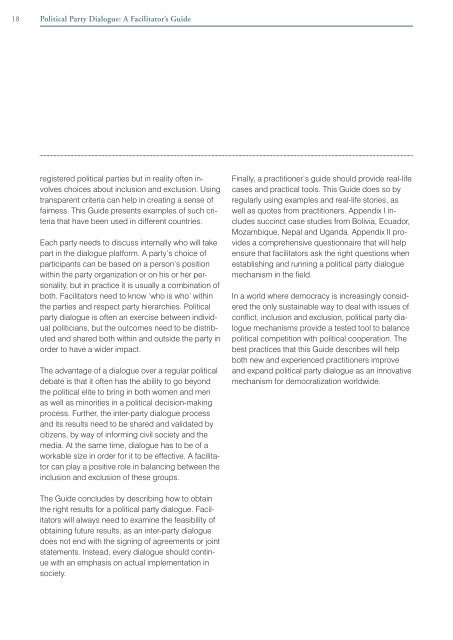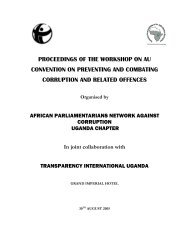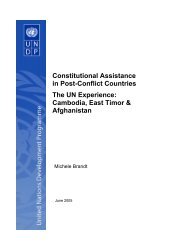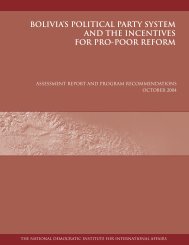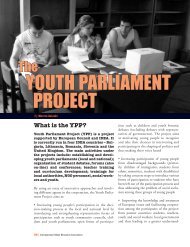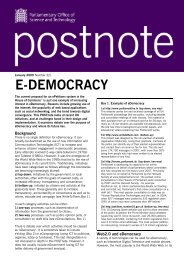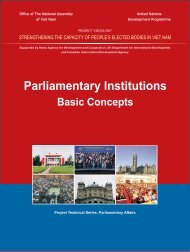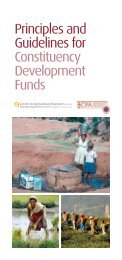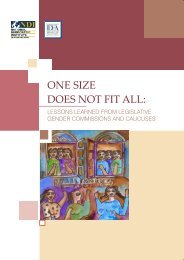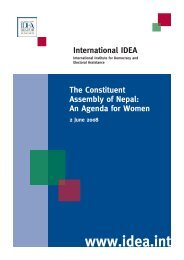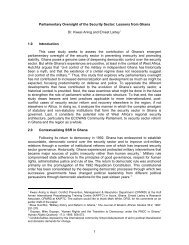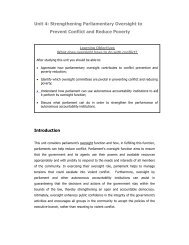Political Party Dialogue â A facilitators guide
Political Party Dialogue â A facilitators guide
Political Party Dialogue â A facilitators guide
Create successful ePaper yourself
Turn your PDF publications into a flip-book with our unique Google optimized e-Paper software.
18 <strong>Political</strong> <strong>Party</strong> <strong>Dialogue</strong>: A Facilitator’s Guideregistered political parties but in reality often involveschoices about inclusion and exclusion. Usingtransparent criteria can help in creating a sense offairness. This Guide presents examples of such criteriathat have been used in different countries.Each party needs to discuss internally who will takepart in the dialogue platform. A party’s choice ofparticipants can be based on a person’s positionwithin the party organization or on his or her personality,but in practice it is usually a combination ofboth. Facilitators need to know ‘who is who’ withinthe parties and respect party hierarchies. <strong>Political</strong>party dialogue is often an exercise between individualpoliticians, but the outcomes need to be distributedand shared both within and outside the party inorder to have a wider impact.The advantage of a dialogue over a regular politicaldebate is that it often has the ability to go beyondthe political elite to bring in both women and menas well as minorities in a political decision-makingprocess. Further, the inter-party dialogue processand its results need to be shared and validated bycitizens, by way of informing civil society and themedia. At the same time, dialogue has to be of aworkable size in order for it to be effective. A facilitatorcan play a positive role in balancing between theinclusion and exclusion of these groups.Finally, a practitioner’s <strong>guide</strong> should provide real-lifecases and practical tools. This Guide does so byregularly using examples and real-life stories, aswell as quotes from practitioners. Appendix I includessuccinct case studies from Bolivia, Ecuador,Mozambique, Nepal and Uganda. Appendix II providesa comprehensive questionnaire that will helpensure that <strong>facilitators</strong> ask the right questions whenestablishing and running a political party dialoguemechanism in the field.In a world where democracy is increasingly consideredthe only sustainable way to deal with issues ofconflict, inclusion and exclusion, political party dialoguemechanisms provide a tested tool to balancepolitical competition with political cooperation. Thebest practices that this Guide describes will helpboth new and experienced practitioners improveand expand political party dialogue as an innovativemechanism for democratization worldwide.The Guide concludes by describing how to obtainthe right results for a political party dialogue. Facilitatorswill always need to examine the feasibility ofobtaining future results, as an inter-party dialoguedoes not end with the signing of agreements or jointstatements. Instead, every dialogue should continuewith an emphasis on actual implementation insociety.


